Seminar Assignment Accounting (Doc)
VerifiedAdded on 2020/04/15
|7
|1748
|34
AI Summary
Contribute Materials
Your contribution can guide someone’s learning journey. Share your
documents today.
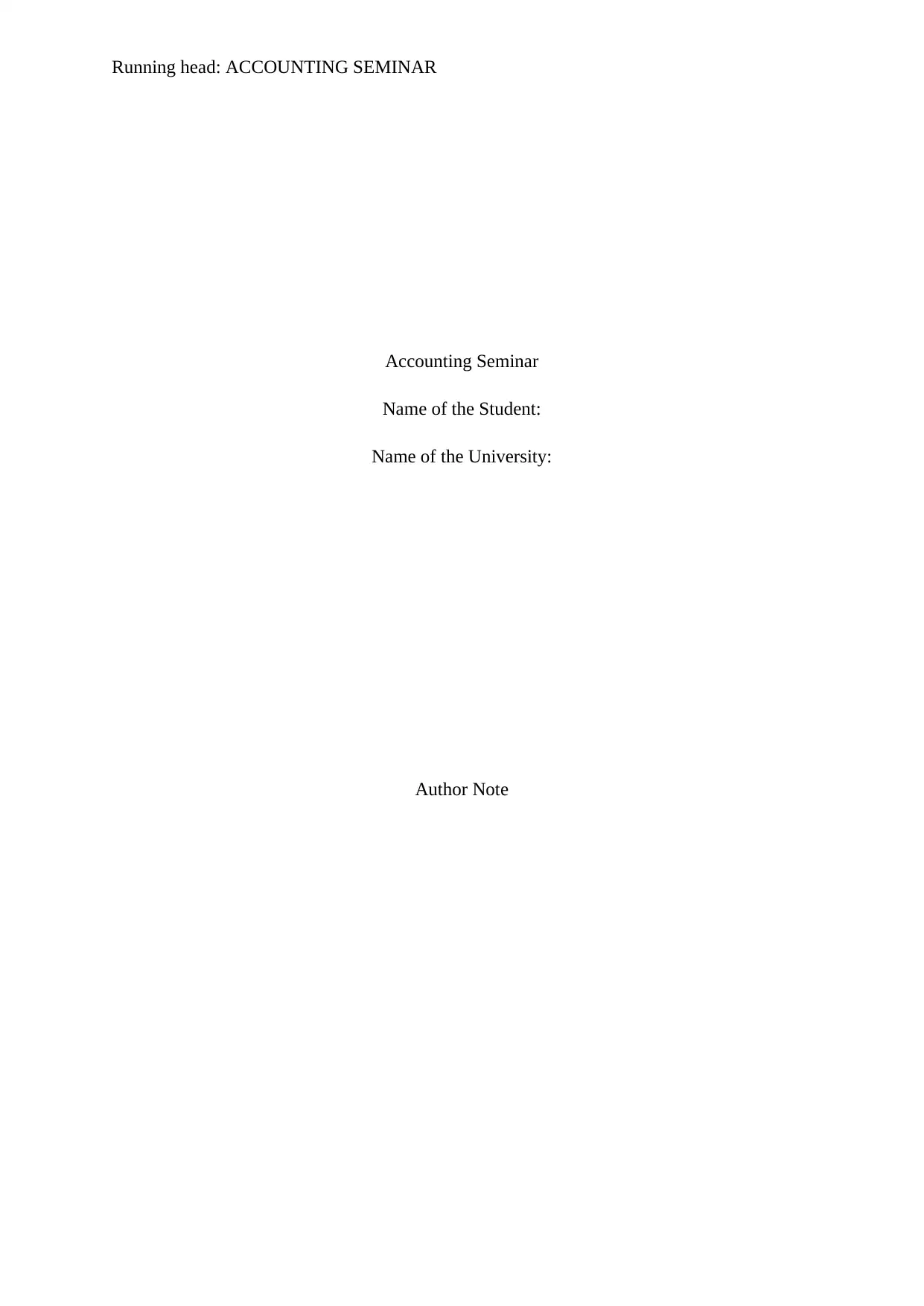
Running head: ACCOUNTING SEMINAR
Accounting Seminar
Name of the Student:
Name of the University:
Author Note
Accounting Seminar
Name of the Student:
Name of the University:
Author Note
Secure Best Marks with AI Grader
Need help grading? Try our AI Grader for instant feedback on your assignments.
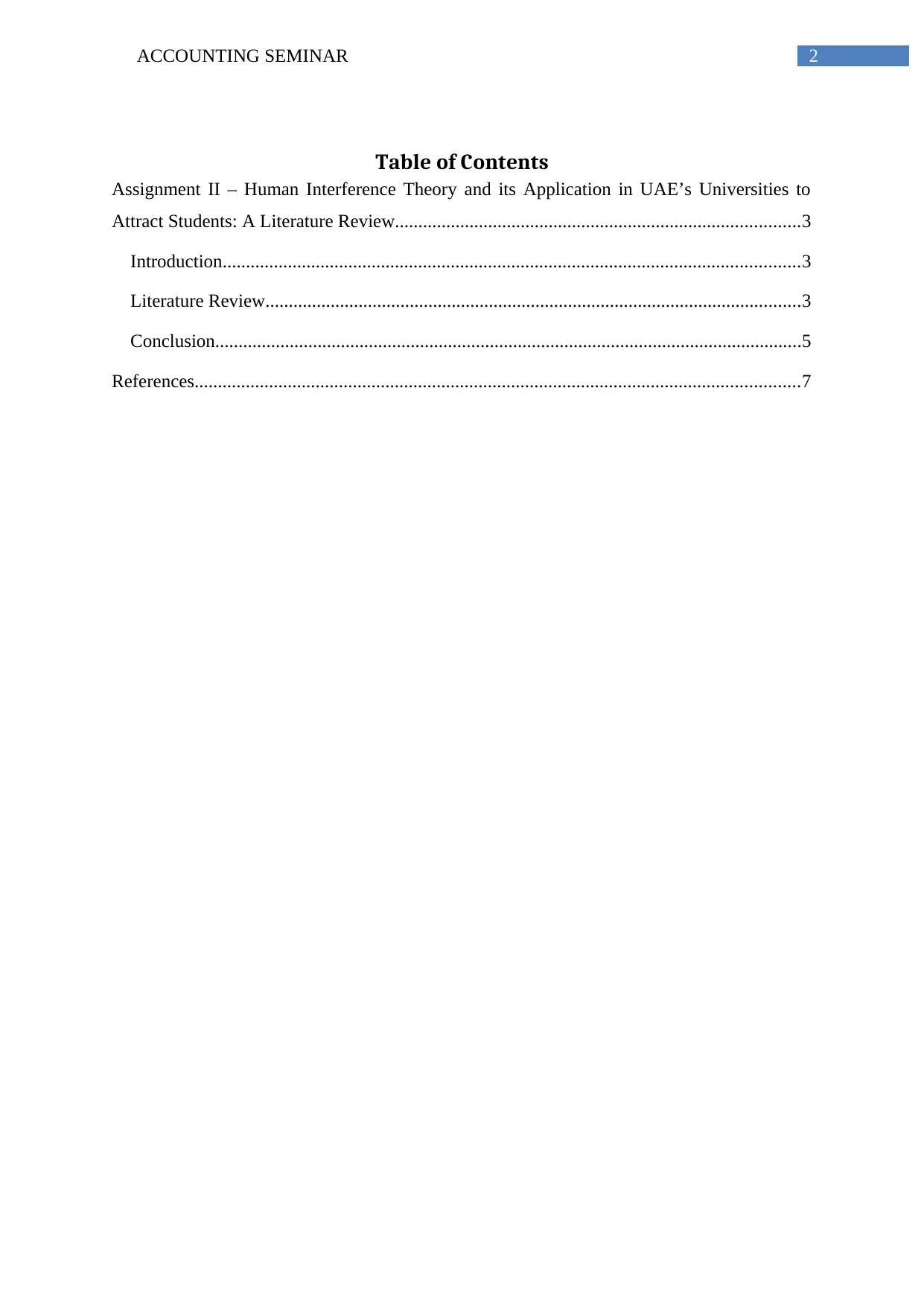
2ACCOUNTING SEMINAR
Table of Contents
Assignment II – Human Interference Theory and its Application in UAE’s Universities to
Attract Students: A Literature Review.......................................................................................3
Introduction............................................................................................................................3
Literature Review...................................................................................................................3
Conclusion..............................................................................................................................5
References..................................................................................................................................7
Table of Contents
Assignment II – Human Interference Theory and its Application in UAE’s Universities to
Attract Students: A Literature Review.......................................................................................3
Introduction............................................................................................................................3
Literature Review...................................................................................................................3
Conclusion..............................................................................................................................5
References..................................................................................................................................7
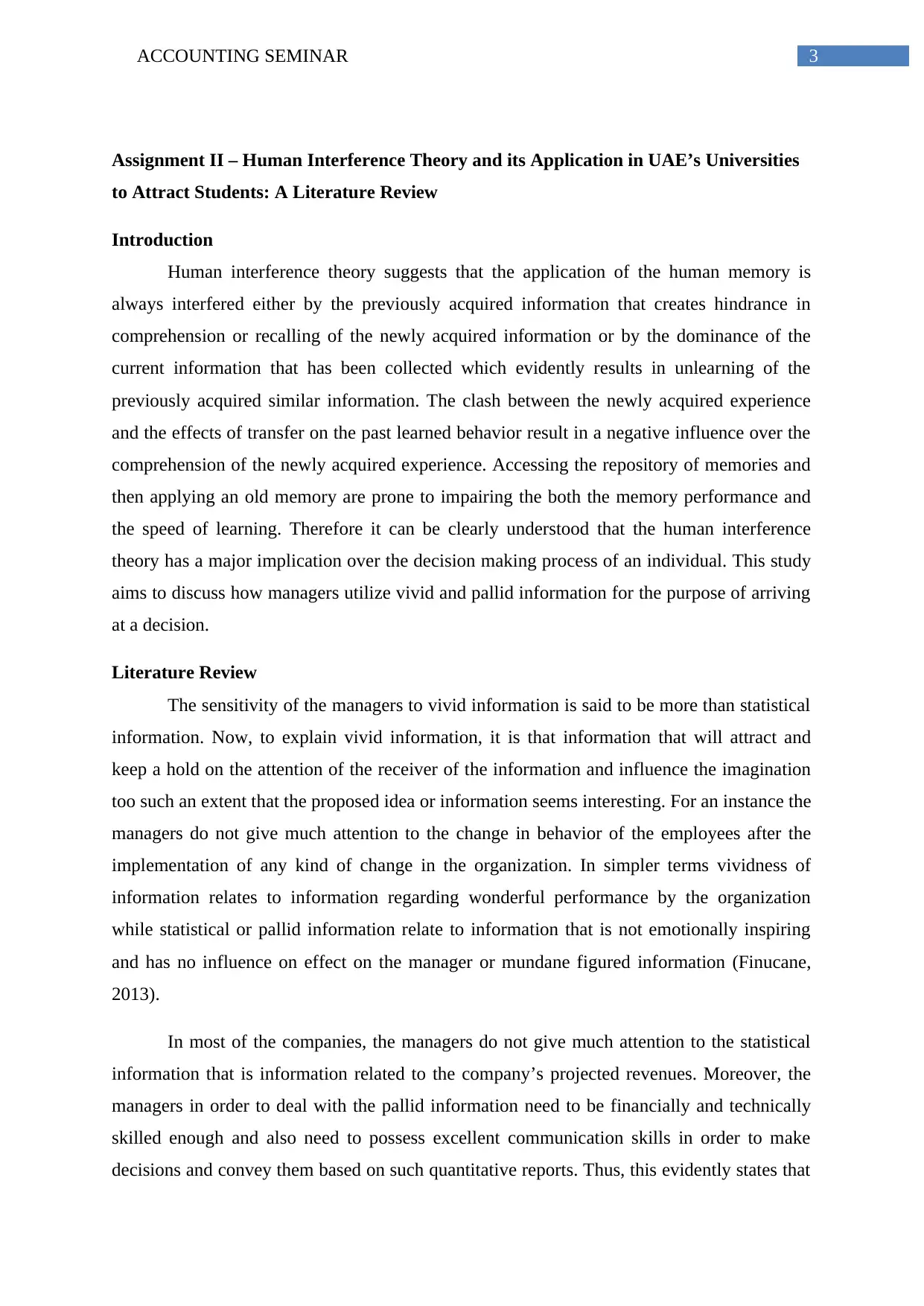
3ACCOUNTING SEMINAR
Assignment II – Human Interference Theory and its Application in UAE’s Universities
to Attract Students: A Literature Review
Introduction
Human interference theory suggests that the application of the human memory is
always interfered either by the previously acquired information that creates hindrance in
comprehension or recalling of the newly acquired information or by the dominance of the
current information that has been collected which evidently results in unlearning of the
previously acquired similar information. The clash between the newly acquired experience
and the effects of transfer on the past learned behavior result in a negative influence over the
comprehension of the newly acquired experience. Accessing the repository of memories and
then applying an old memory are prone to impairing the both the memory performance and
the speed of learning. Therefore it can be clearly understood that the human interference
theory has a major implication over the decision making process of an individual. This study
aims to discuss how managers utilize vivid and pallid information for the purpose of arriving
at a decision.
Literature Review
The sensitivity of the managers to vivid information is said to be more than statistical
information. Now, to explain vivid information, it is that information that will attract and
keep a hold on the attention of the receiver of the information and influence the imagination
too such an extent that the proposed idea or information seems interesting. For an instance the
managers do not give much attention to the change in behavior of the employees after the
implementation of any kind of change in the organization. In simpler terms vividness of
information relates to information regarding wonderful performance by the organization
while statistical or pallid information relate to information that is not emotionally inspiring
and has no influence on effect on the manager or mundane figured information (Finucane,
2013).
In most of the companies, the managers do not give much attention to the statistical
information that is information related to the company’s projected revenues. Moreover, the
managers in order to deal with the pallid information need to be financially and technically
skilled enough and also need to possess excellent communication skills in order to make
decisions and convey them based on such quantitative reports. Thus, this evidently states that
Assignment II – Human Interference Theory and its Application in UAE’s Universities
to Attract Students: A Literature Review
Introduction
Human interference theory suggests that the application of the human memory is
always interfered either by the previously acquired information that creates hindrance in
comprehension or recalling of the newly acquired information or by the dominance of the
current information that has been collected which evidently results in unlearning of the
previously acquired similar information. The clash between the newly acquired experience
and the effects of transfer on the past learned behavior result in a negative influence over the
comprehension of the newly acquired experience. Accessing the repository of memories and
then applying an old memory are prone to impairing the both the memory performance and
the speed of learning. Therefore it can be clearly understood that the human interference
theory has a major implication over the decision making process of an individual. This study
aims to discuss how managers utilize vivid and pallid information for the purpose of arriving
at a decision.
Literature Review
The sensitivity of the managers to vivid information is said to be more than statistical
information. Now, to explain vivid information, it is that information that will attract and
keep a hold on the attention of the receiver of the information and influence the imagination
too such an extent that the proposed idea or information seems interesting. For an instance the
managers do not give much attention to the change in behavior of the employees after the
implementation of any kind of change in the organization. In simpler terms vividness of
information relates to information regarding wonderful performance by the organization
while statistical or pallid information relate to information that is not emotionally inspiring
and has no influence on effect on the manager or mundane figured information (Finucane,
2013).
In most of the companies, the managers do not give much attention to the statistical
information that is information related to the company’s projected revenues. Moreover, the
managers in order to deal with the pallid information need to be financially and technically
skilled enough and also need to possess excellent communication skills in order to make
decisions and convey them based on such quantitative reports. Thus, this evidently states that
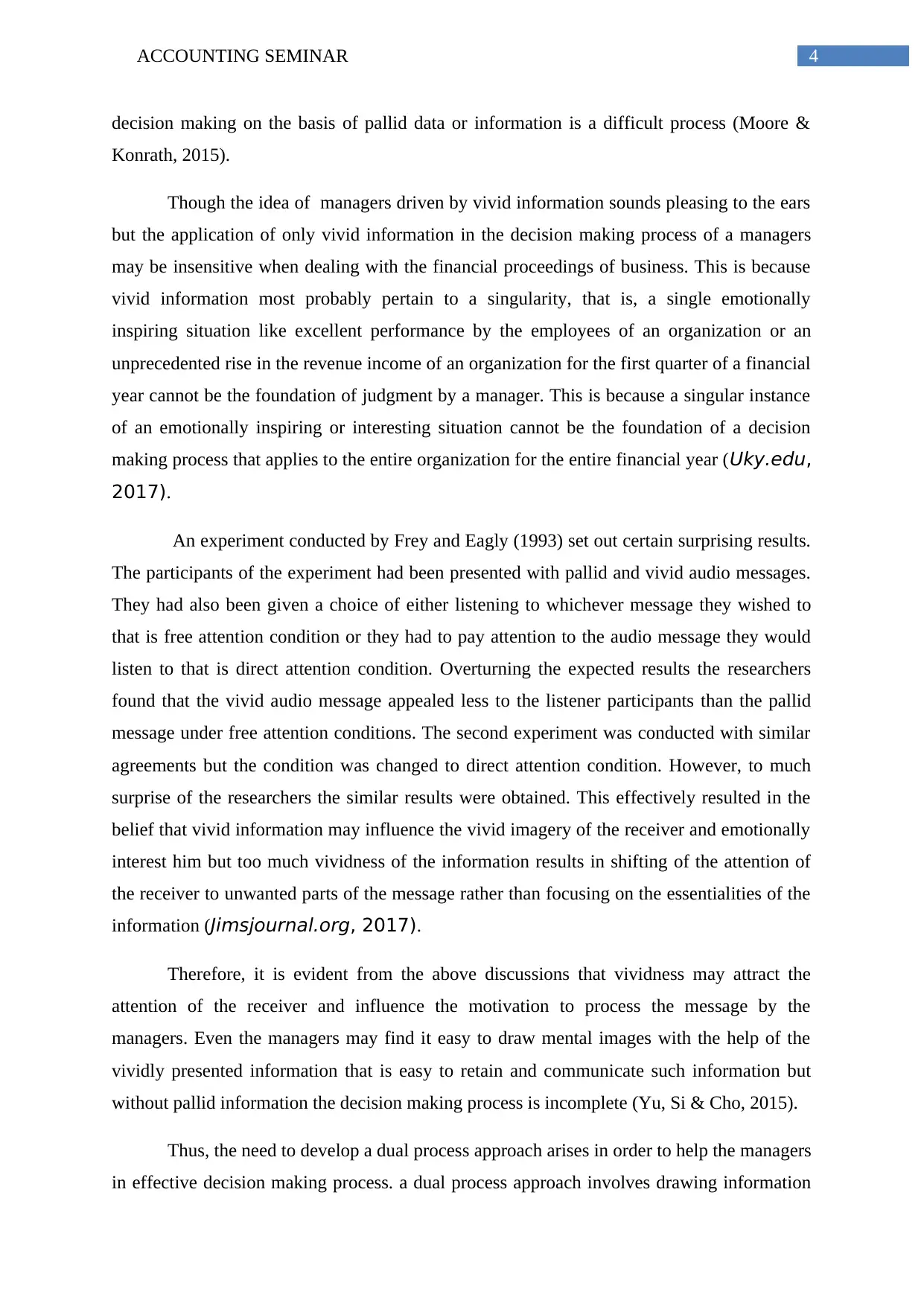
4ACCOUNTING SEMINAR
decision making on the basis of pallid data or information is a difficult process (Moore &
Konrath, 2015).
Though the idea of managers driven by vivid information sounds pleasing to the ears
but the application of only vivid information in the decision making process of a managers
may be insensitive when dealing with the financial proceedings of business. This is because
vivid information most probably pertain to a singularity, that is, a single emotionally
inspiring situation like excellent performance by the employees of an organization or an
unprecedented rise in the revenue income of an organization for the first quarter of a financial
year cannot be the foundation of judgment by a manager. This is because a singular instance
of an emotionally inspiring or interesting situation cannot be the foundation of a decision
making process that applies to the entire organization for the entire financial year (Uky.edu,
2017).
An experiment conducted by Frey and Eagly (1993) set out certain surprising results.
The participants of the experiment had been presented with pallid and vivid audio messages.
They had also been given a choice of either listening to whichever message they wished to
that is free attention condition or they had to pay attention to the audio message they would
listen to that is direct attention condition. Overturning the expected results the researchers
found that the vivid audio message appealed less to the listener participants than the pallid
message under free attention conditions. The second experiment was conducted with similar
agreements but the condition was changed to direct attention condition. However, to much
surprise of the researchers the similar results were obtained. This effectively resulted in the
belief that vivid information may influence the vivid imagery of the receiver and emotionally
interest him but too much vividness of the information results in shifting of the attention of
the receiver to unwanted parts of the message rather than focusing on the essentialities of the
information (Jimsjournal.org, 2017).
Therefore, it is evident from the above discussions that vividness may attract the
attention of the receiver and influence the motivation to process the message by the
managers. Even the managers may find it easy to draw mental images with the help of the
vividly presented information that is easy to retain and communicate such information but
without pallid information the decision making process is incomplete (Yu, Si & Cho, 2015).
Thus, the need to develop a dual process approach arises in order to help the managers
in effective decision making process. a dual process approach involves drawing information
decision making on the basis of pallid data or information is a difficult process (Moore &
Konrath, 2015).
Though the idea of managers driven by vivid information sounds pleasing to the ears
but the application of only vivid information in the decision making process of a managers
may be insensitive when dealing with the financial proceedings of business. This is because
vivid information most probably pertain to a singularity, that is, a single emotionally
inspiring situation like excellent performance by the employees of an organization or an
unprecedented rise in the revenue income of an organization for the first quarter of a financial
year cannot be the foundation of judgment by a manager. This is because a singular instance
of an emotionally inspiring or interesting situation cannot be the foundation of a decision
making process that applies to the entire organization for the entire financial year (Uky.edu,
2017).
An experiment conducted by Frey and Eagly (1993) set out certain surprising results.
The participants of the experiment had been presented with pallid and vivid audio messages.
They had also been given a choice of either listening to whichever message they wished to
that is free attention condition or they had to pay attention to the audio message they would
listen to that is direct attention condition. Overturning the expected results the researchers
found that the vivid audio message appealed less to the listener participants than the pallid
message under free attention conditions. The second experiment was conducted with similar
agreements but the condition was changed to direct attention condition. However, to much
surprise of the researchers the similar results were obtained. This effectively resulted in the
belief that vivid information may influence the vivid imagery of the receiver and emotionally
interest him but too much vividness of the information results in shifting of the attention of
the receiver to unwanted parts of the message rather than focusing on the essentialities of the
information (Jimsjournal.org, 2017).
Therefore, it is evident from the above discussions that vividness may attract the
attention of the receiver and influence the motivation to process the message by the
managers. Even the managers may find it easy to draw mental images with the help of the
vividly presented information that is easy to retain and communicate such information but
without pallid information the decision making process is incomplete (Yu, Si & Cho, 2015).
Thus, the need to develop a dual process approach arises in order to help the managers
in effective decision making process. a dual process approach involves drawing information
Secure Best Marks with AI Grader
Need help grading? Try our AI Grader for instant feedback on your assignments.
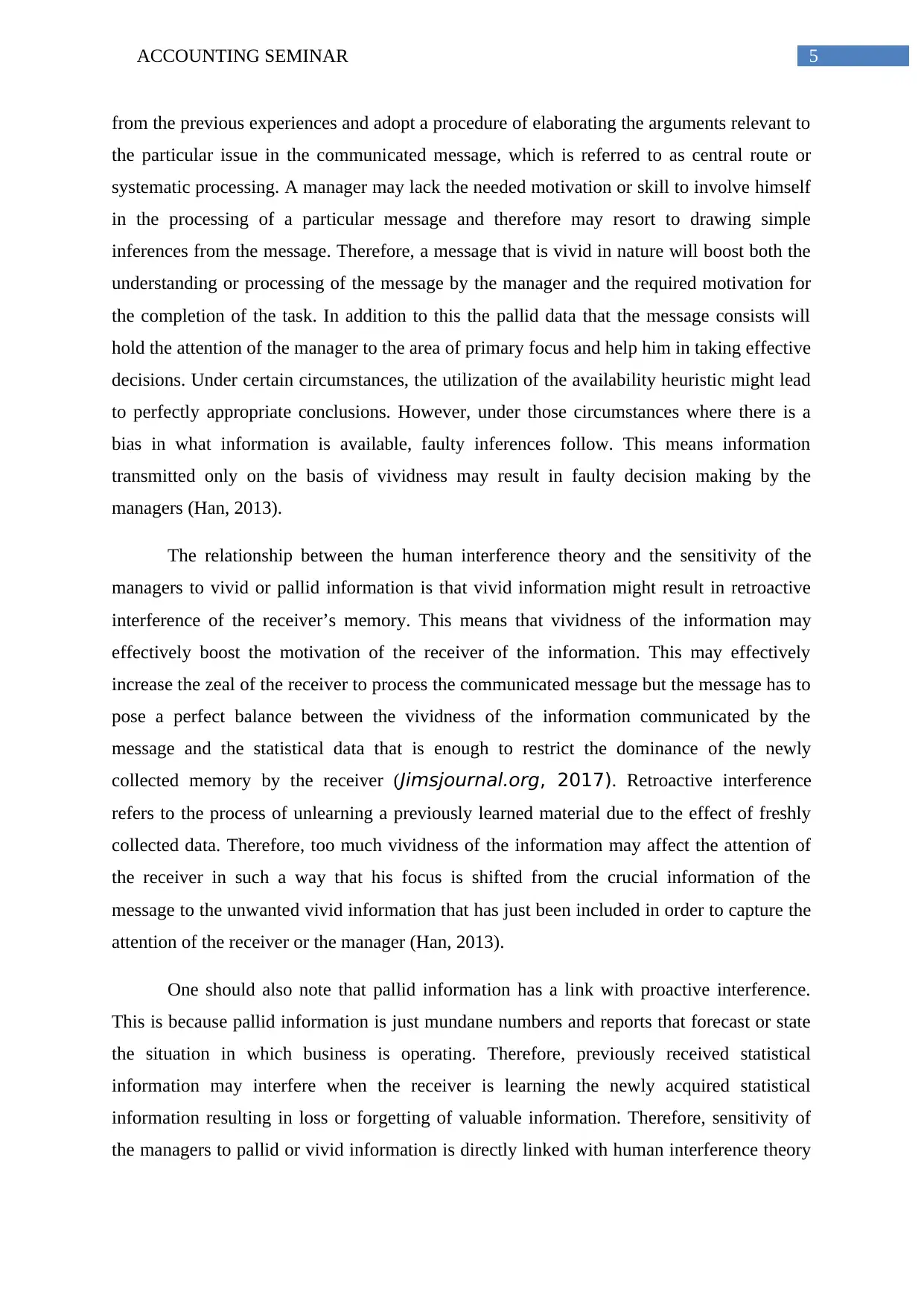
5ACCOUNTING SEMINAR
from the previous experiences and adopt a procedure of elaborating the arguments relevant to
the particular issue in the communicated message, which is referred to as central route or
systematic processing. A manager may lack the needed motivation or skill to involve himself
in the processing of a particular message and therefore may resort to drawing simple
inferences from the message. Therefore, a message that is vivid in nature will boost both the
understanding or processing of the message by the manager and the required motivation for
the completion of the task. In addition to this the pallid data that the message consists will
hold the attention of the manager to the area of primary focus and help him in taking effective
decisions. Under certain circumstances, the utilization of the availability heuristic might lead
to perfectly appropriate conclusions. However, under those circumstances where there is a
bias in what information is available, faulty inferences follow. This means information
transmitted only on the basis of vividness may result in faulty decision making by the
managers (Han, 2013).
The relationship between the human interference theory and the sensitivity of the
managers to vivid or pallid information is that vivid information might result in retroactive
interference of the receiver’s memory. This means that vividness of the information may
effectively boost the motivation of the receiver of the information. This may effectively
increase the zeal of the receiver to process the communicated message but the message has to
pose a perfect balance between the vividness of the information communicated by the
message and the statistical data that is enough to restrict the dominance of the newly
collected memory by the receiver (Jimsjournal.org, 2017). Retroactive interference
refers to the process of unlearning a previously learned material due to the effect of freshly
collected data. Therefore, too much vividness of the information may affect the attention of
the receiver in such a way that his focus is shifted from the crucial information of the
message to the unwanted vivid information that has just been included in order to capture the
attention of the receiver or the manager (Han, 2013).
One should also note that pallid information has a link with proactive interference.
This is because pallid information is just mundane numbers and reports that forecast or state
the situation in which business is operating. Therefore, previously received statistical
information may interfere when the receiver is learning the newly acquired statistical
information resulting in loss or forgetting of valuable information. Therefore, sensitivity of
the managers to pallid or vivid information is directly linked with human interference theory
from the previous experiences and adopt a procedure of elaborating the arguments relevant to
the particular issue in the communicated message, which is referred to as central route or
systematic processing. A manager may lack the needed motivation or skill to involve himself
in the processing of a particular message and therefore may resort to drawing simple
inferences from the message. Therefore, a message that is vivid in nature will boost both the
understanding or processing of the message by the manager and the required motivation for
the completion of the task. In addition to this the pallid data that the message consists will
hold the attention of the manager to the area of primary focus and help him in taking effective
decisions. Under certain circumstances, the utilization of the availability heuristic might lead
to perfectly appropriate conclusions. However, under those circumstances where there is a
bias in what information is available, faulty inferences follow. This means information
transmitted only on the basis of vividness may result in faulty decision making by the
managers (Han, 2013).
The relationship between the human interference theory and the sensitivity of the
managers to vivid or pallid information is that vivid information might result in retroactive
interference of the receiver’s memory. This means that vividness of the information may
effectively boost the motivation of the receiver of the information. This may effectively
increase the zeal of the receiver to process the communicated message but the message has to
pose a perfect balance between the vividness of the information communicated by the
message and the statistical data that is enough to restrict the dominance of the newly
collected memory by the receiver (Jimsjournal.org, 2017). Retroactive interference
refers to the process of unlearning a previously learned material due to the effect of freshly
collected data. Therefore, too much vividness of the information may affect the attention of
the receiver in such a way that his focus is shifted from the crucial information of the
message to the unwanted vivid information that has just been included in order to capture the
attention of the receiver or the manager (Han, 2013).
One should also note that pallid information has a link with proactive interference.
This is because pallid information is just mundane numbers and reports that forecast or state
the situation in which business is operating. Therefore, previously received statistical
information may interfere when the receiver is learning the newly acquired statistical
information resulting in loss or forgetting of valuable information. Therefore, sensitivity of
the managers to pallid or vivid information is directly linked with human interference theory
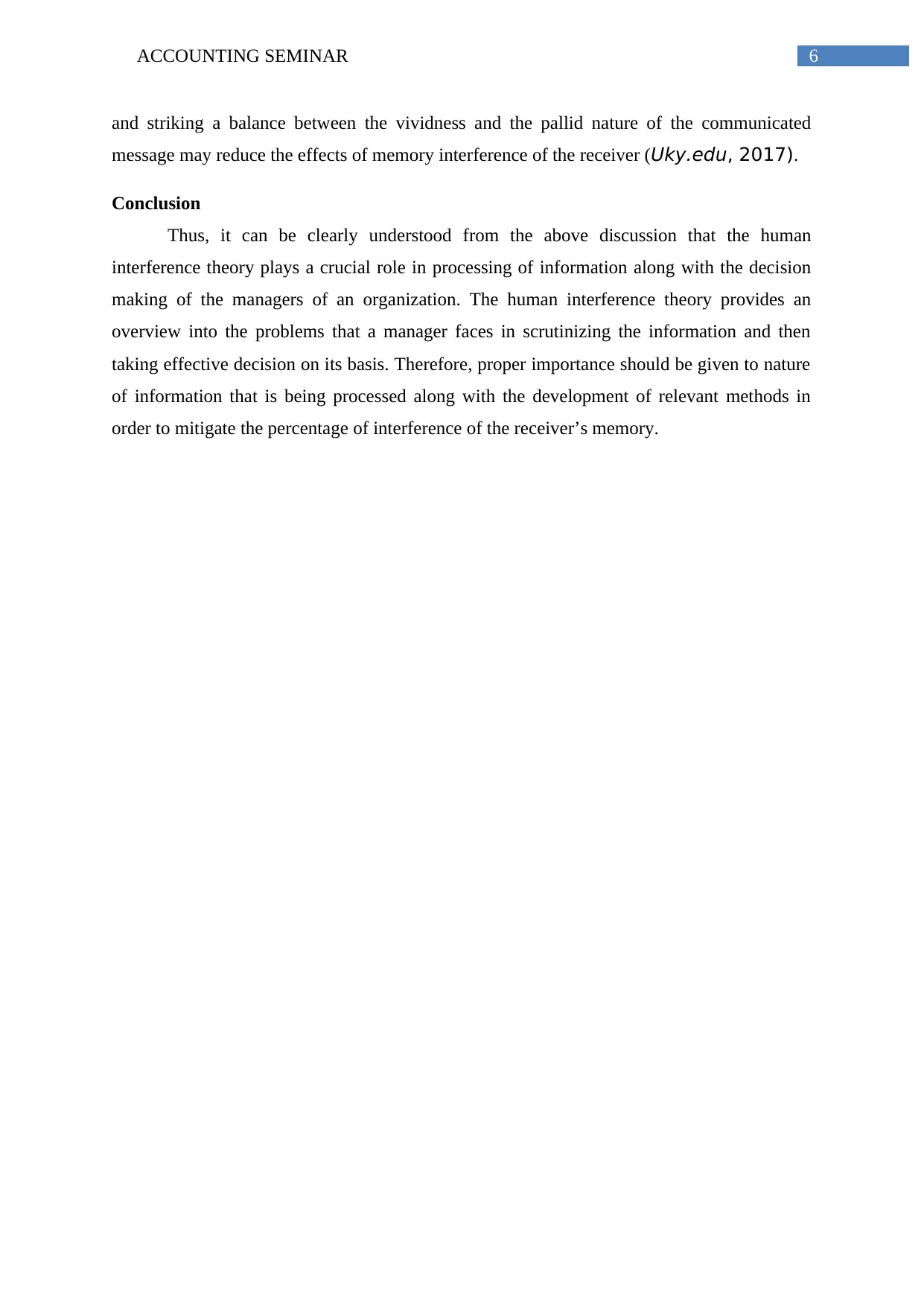
6ACCOUNTING SEMINAR
and striking a balance between the vividness and the pallid nature of the communicated
message may reduce the effects of memory interference of the receiver (Uky.edu, 2017).
Conclusion
Thus, it can be clearly understood from the above discussion that the human
interference theory plays a crucial role in processing of information along with the decision
making of the managers of an organization. The human interference theory provides an
overview into the problems that a manager faces in scrutinizing the information and then
taking effective decision on its basis. Therefore, proper importance should be given to nature
of information that is being processed along with the development of relevant methods in
order to mitigate the percentage of interference of the receiver’s memory.
and striking a balance between the vividness and the pallid nature of the communicated
message may reduce the effects of memory interference of the receiver (Uky.edu, 2017).
Conclusion
Thus, it can be clearly understood from the above discussion that the human
interference theory plays a crucial role in processing of information along with the decision
making of the managers of an organization. The human interference theory provides an
overview into the problems that a manager faces in scrutinizing the information and then
taking effective decision on its basis. Therefore, proper importance should be given to nature
of information that is being processed along with the development of relevant methods in
order to mitigate the percentage of interference of the receiver’s memory.
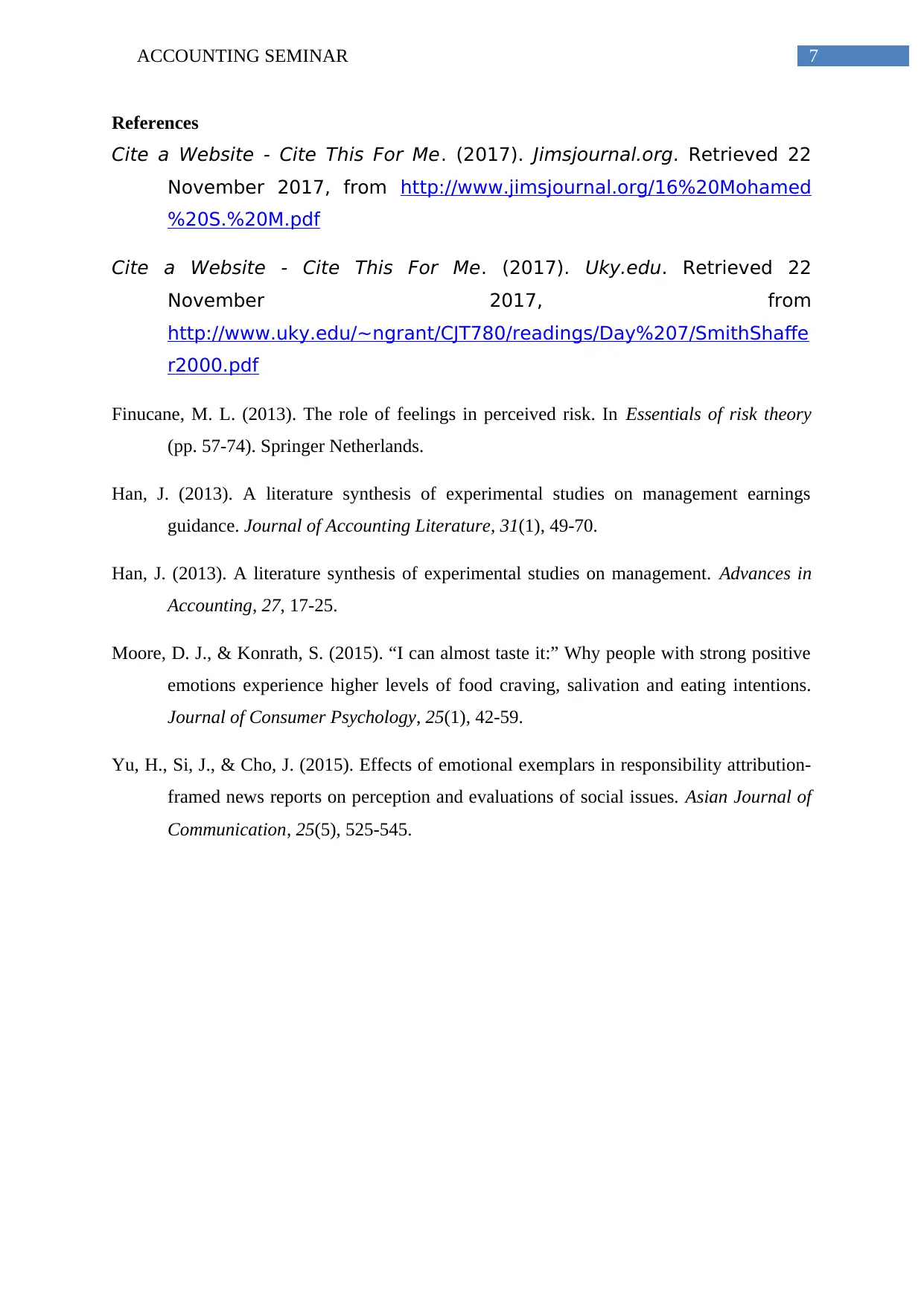
7ACCOUNTING SEMINAR
References
Cite a Website - Cite This For Me. (2017). Jimsjournal.org. Retrieved 22
November 2017, from http://www.jimsjournal.org/16%20Mohamed
%20S.%20M.pdf
Cite a Website - Cite This For Me. (2017). Uky.edu. Retrieved 22
November 2017, from
http://www.uky.edu/~ngrant/CJT780/readings/Day%207/SmithShaffe
r2000.pdf
Finucane, M. L. (2013). The role of feelings in perceived risk. In Essentials of risk theory
(pp. 57-74). Springer Netherlands.
Han, J. (2013). A literature synthesis of experimental studies on management earnings
guidance. Journal of Accounting Literature, 31(1), 49-70.
Han, J. (2013). A literature synthesis of experimental studies on management. Advances in
Accounting, 27, 17-25.
Moore, D. J., & Konrath, S. (2015). “I can almost taste it:” Why people with strong positive
emotions experience higher levels of food craving, salivation and eating intentions.
Journal of Consumer Psychology, 25(1), 42-59.
Yu, H., Si, J., & Cho, J. (2015). Effects of emotional exemplars in responsibility attribution-
framed news reports on perception and evaluations of social issues. Asian Journal of
Communication, 25(5), 525-545.
References
Cite a Website - Cite This For Me. (2017). Jimsjournal.org. Retrieved 22
November 2017, from http://www.jimsjournal.org/16%20Mohamed
%20S.%20M.pdf
Cite a Website - Cite This For Me. (2017). Uky.edu. Retrieved 22
November 2017, from
http://www.uky.edu/~ngrant/CJT780/readings/Day%207/SmithShaffe
r2000.pdf
Finucane, M. L. (2013). The role of feelings in perceived risk. In Essentials of risk theory
(pp. 57-74). Springer Netherlands.
Han, J. (2013). A literature synthesis of experimental studies on management earnings
guidance. Journal of Accounting Literature, 31(1), 49-70.
Han, J. (2013). A literature synthesis of experimental studies on management. Advances in
Accounting, 27, 17-25.
Moore, D. J., & Konrath, S. (2015). “I can almost taste it:” Why people with strong positive
emotions experience higher levels of food craving, salivation and eating intentions.
Journal of Consumer Psychology, 25(1), 42-59.
Yu, H., Si, J., & Cho, J. (2015). Effects of emotional exemplars in responsibility attribution-
framed news reports on perception and evaluations of social issues. Asian Journal of
Communication, 25(5), 525-545.
1 out of 7
Related Documents
Your All-in-One AI-Powered Toolkit for Academic Success.
+13062052269
info@desklib.com
Available 24*7 on WhatsApp / Email
![[object Object]](/_next/static/media/star-bottom.7253800d.svg)
Unlock your academic potential
© 2024 | Zucol Services PVT LTD | All rights reserved.
